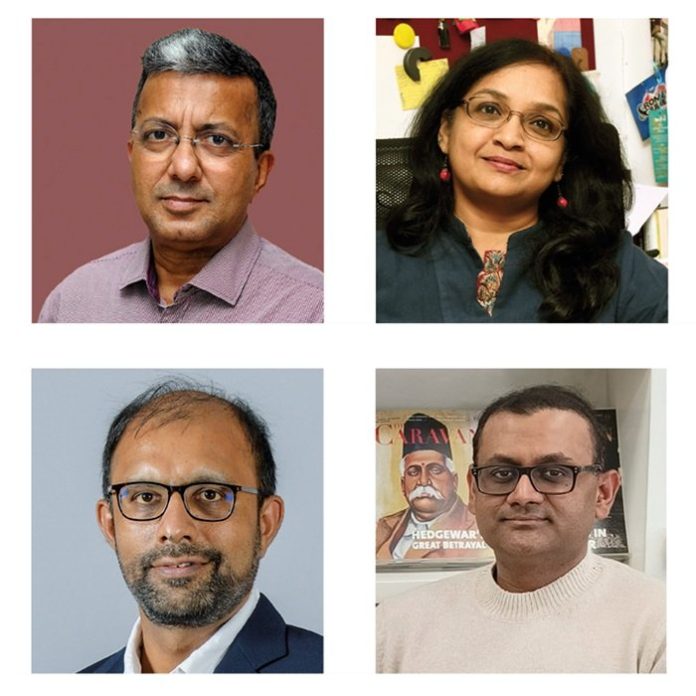
In a previous article, correspondent Priyanka Tanwar interacted with Ruben Banerjee, journalist, author of Editor Missing: The Media in Today’s India and former editor of Outlook, Vaishna Roy, editor Frontline, Pundi Sriram, CPO of The Hindu Group, and Anant Nath, executive publisher at Delhi Press and editor, The Caravan, to discuss the current state of news magazines in India along with the challenges of going digital.
Part two of the article delves into the challenges faced by news magazines, strategies to target readers and convince them to go back to print, and steps publishers can take to revive news magazines.
Challenges faced by news magazines
Apart from money, which is a huge constraint, another challenge is a general bankruptcy of great ideas, Banerjee says. The problem, he says, lies with the owners to a great extent as they shy away from taking a stand, which is reflected in the content. That is the reason why magazines are writing more on art and culture, forest and environmental issues, he said. “These are important topics but they must not be at the cost of pressing and demanding coverage, he argued.
It is true that a lot of people don’t want to read and just want to watch reels and digital content, Roy said, adding there’s a great loss of focus and attention span as they do not want to spend more than 10 minutes on reading a long-form article. But equally true is that there are people who are spending 6 to 7 minutes on Frontline stories published online, she said.
“I feel that there is a lot of noise in the media space right now. Also, within that noise is a core group of serious readers who know they can go to a particular place to get serious news that they can believe in. I think those people keep coming back to us. Our challenge will be to include more and more people within that core group,” Roy added.
According to Nath, the Indian news media (magazines, newspapers and TV channels) is not very anti-establishment as they are too dependent on government revenues for advertising. They are dependent on government patronage for multiple reasons such as government licenses and benefits, Nath said. As a result, the news media is generally not confrontational, not objective, not anti-establishment, and doesn’t speak the truth.
“The Indian news media is not able to cater to the readers’ demand who, even if they are supporters of the present government, want to know where it is going wrong. If the top news channels, newspapers, and news magazines are not objective or critical of the government, where will readers go? News organizations should become objective in the interest of the readers and their own survival because, in the digital age, everybody is now looking at readers to make revenue,” Nath added.
Earlier, the model was to make money from advertisers and give the content for free or at a very minimal cost. But in the last three years, everybody is trying to move towards a paywall because they realized they cannot make enough money from advertising in the digital space compared to the golden days of print, he said. “So, how does one get readers to pay? They will not pay for coverage that is not objective. They will not pay for PR coverage of the government. They want to know what is happening in the country. So, news organizations that are more objective or more independent will have a greater potential to generate revenue from readers,” he argued.
How to make readers go back to print
The Frontline readers are slightly bolder, Roy said. The magazine now has a lot of culture-related stories, book reviews, related interviews, and serious cinema. There was a time when Frontline would not do any reviews. “There’s a lighter touch to the magazine on the whole now,” she said.
“The language that we now use is more friendly, and not academic, dull, boring, and heavy. We are making it more lighter and attractive. We hope to bring down the readership age to graduates and students preparing for competitive exams. We have a vast readership among people in government jobs, ministers, writers, authors, artists, academics, scholars, and bureaucrats. A lot of people in the armed forces read our magazine,” Roy added.
The Caravan is meant for the serious, intellectual, well-read, and curious audience – anybody who has an interest in Indian politics from a slightly liberal perspective, Nath said. The magazine is based on liberal values, a rationalistic approach, and speaking truth to power. So anybody who has an interest in that kind of journalism and content is a Caravan reader, he explained.
“It’s a very diverse, global, cosmopolitan audience that is very curious about the finer things in life from an intellectual perspective. It’s very diffused across the country. It’s a very young audience if you were to compare it with some of the other magazines such as Frontline and India Today, which have a slightly older, mature audience,” he said.
The Caravan resonates with young professionals and intends to target students, Nath said, adding they are trying to get institutional subscriptions, programs in colleges and universities that have the kind of subjects where The Caravan would be relevant, such as law, journalism, and social science colleges. These are the colleges where you would find a Caravan reader, Nath said. “I am not saying engineering and medical students won’t read The Caravan but the chances of finding a Caravan reader are higher in law, journalism, and social science colleges where students have an interest in national, political, and social affairs. Apart from that, we have an active Instagram page and we want to do more events around topics of national interest – that’s the playbook that we are trying,” he added.
All the Delhi Press magazines went through a fall during the Covid-19 pandemic and the media house is working on resurrecting them, Nath said. “We are using digital to market these magazines. All our magazines have a website. We have put the content behind a paywall because we want readers to subscribe. While we have not regained the pre-Covid numbers, we are moving toward it. Through a mix of strong digital marketing and a strong effort on subscriptions, I feel we will be able to have enough of a critical mass to make this whole effort sustainable and viable,” he added.
Right now we are focusing on Hindi but we want to grow our subscriptions in other Indian languages such as Bengali, Tamil, Telugu, Kannada, Marathi, Gujarati, and Malayalam, Nath said, it’s a slow burn but they are seeing encouraging signs. If we can fix the model of delivery, then people would be willing to pay for it, he said.
Reviving news magazines
“Primarily, the magazine owners need to grow a spine – that is the first primary factor for news magazines to survive. Journalists and editors working with these news magazines must have a spine too. Otherwise, the journalism we are doing is ruthless,” Banerjee said.
According to Roy, publishers should stop imagining that everything has to be trimmed down for the reader. “Any magazine you read, any website you go to, any newspaper you read – everything is short, everyone has flashy videos, rapid five-minute stories. I don’t even want to be in that space. I am going to be different, I want to stand out, I am going to give you meaningful stuff. If you have time and the inclination, you will come to me for a particular thing,” she added.
She says her solution is to retain originality and uniqueness in this mad world of everybody doing the same things, adding she met many 25-year-olds who are quite happy to sit down with a history book.
“I am challenging this notion that no 25-year-old will spend more than three minutes reading anything. No – there’s a definite universe of people who want serious news, in-depth long-form stories and aren’t afraid of reading. If I can be true to that readership, it’s okay, I don’t want to be a mass product. Everybody want to be mass, everybody wants numbers and millions of readers, but they end up doing the same thing. There’s nothing to differentiate one news website from another. If you can have a distinct voice and stand out distinctly for what you are and what you deal with, you’ll be able to mark your place among serious readers,” Roy said about Frontline’s brand image and identity.
The decline in magazine readership is not because people don’t want to read in print, it’s because access to print has become difficult, Nath said, adding the potential of print is far more than it is being utilized. The problem is at the distribution end. And when that gets fixed, then circulation will go up, he said.
Two magazines from the publishing house have grown over their pre-Covid levels – The Caravan and Champak, Nath said. Today, The Caravan has the highest circulation in the last 12 years.
“Champak went through a dip even before the Covid-19 pandemic and today, it has a higher circulation compared to the last 10 years. We have been marketing it far more strongly with the focus moving from the newsstand to subscription. Today, we have far more subscribers because parents want their children to read something. The kids might want to go on YouTube but most parents want their children to read something and preferably in a local language, Nath said.
North Indian parents might say my child should read Hindi, a Tamil parent might want Tamil, while a Marathi parent might say my child should know Marathi, Nath said, but how do they get children to read? “Champak is a magazine that has got a great amount of trust and recall among parents as everybody has read it at some point. We have gone heavy on marketing Champak via online, telecalling, and other channels. The demand is there but we need to change the distribution model. Champak is a young brand, so there is a lot of dynamism. We make sure we have fresh blood to market it for us,” he added.
















